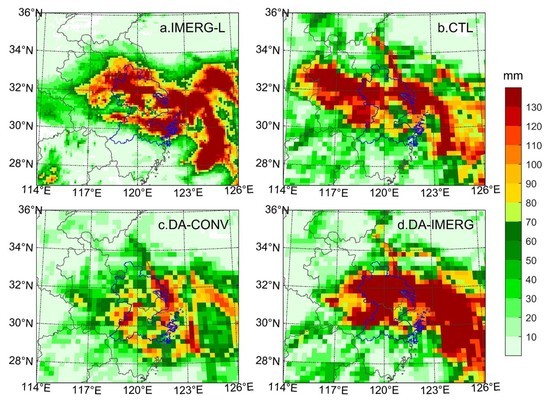Data Assimilation of High-Resolution Satellite Rainfall Product Improves Rainfall Simulation Associated with Landfalling Tropical Cyclones in the Yangtze River Delta
Abstract
1. Introduction
2. Materials and Methods
2.1. Study Area
2.2. Datasets
2.3. Method Used
2.3.1. WRF Model Configuration
2.3.2. Experiments Design
2.3.3. Evaluation Metrics
3. Results
3.1. Evaluation of IMERG Precipitation Products
3.1.1. Temporal and Spatial Distribution of IMERG Precipitation
3.1.2. Evaluated the Deviation and Detection Capability in Hourly Scale at the Gauge Stations
3.2. Evaluation of WRF Model with 4D-Var
3.2.1. Brief Analyzed the Assimilation Increment
3.2.2. Temporal and Spatial Distribution of Precipitation
3.2.3. Statistical Performance of Assimilation Experiments at the Grid Scale
3.2.4. Evaluated of Rainfall Forecast Skill Scores
4. Discussion
5. Conclusions
Author Contributions
Funding
Acknowledgments
Conflicts of Interest
Appendix A. The Method of WRF 4D-Var
References
- CRED. Natural Disasters 2018. Brussels: CRED. 2019. Available online: https://emdat.be/sites/default/fles/adsr_2018.pdf (accessed on 1 November 2019).
- Smith, J.A.; Villarini, G.; Baeck, M.L. Mixture distributions and the hydroclimatology of extreme rainfall and flooding in the eastern United States. J. Hydrometeorol. 2011, 12, 294–309. [Google Scholar] [CrossRef]
- Galvin, J.F.P. The development, track and destruction of Typhoon Haiyan. Weather 2015, 69, 307–309. [Google Scholar] [CrossRef]
- Lu, J.; Feng, T.; Li, J.; Cai, Z.; Xu, X.; Li, L.; Li, J. Impact of assimilating Himawari-8-Derived layered precipitable water with varying cumulus and microphysics parameterization schemes on the simulation of Typhoon Hato. J. Geophys. Res. Atmos. 2019, 124, 3050–3071. [Google Scholar] [CrossRef]
- Giorgi, F.; Gutowski, W.J. Regional dynamical downscaling and the CORDEX initiative. Annu. Rev. Environ. Resour. 2015, 40, 467–490. [Google Scholar] [CrossRef]
- Skamarock, W.C.; Klemp, J.B. A time-split nonhydrostatic atmospheric model for weather research and forecasting applications. J. Comput. Phys. 2008, 227, 3465–3485. [Google Scholar] [CrossRef]
- Mure-Ravaud, M.; Ishida, K.; Kavvas, M.L.; Yegorova, E.; Kanney, J. Numerical reconstruction of the intense precipitation and moisture transport fields for six tropical cyclones affecting the eastern United States. Sci. Total. Environ. 2019, 665, 1111–1124. [Google Scholar] [CrossRef]
- Bushair, M.T.; Kumar, P.; Gairola, R.M. Evaluation and assimilation of various satellite-derived rainfall products over India. Int. J. Remote Sens. 2019, 40, 5315–5338. [Google Scholar] [CrossRef]
- Lopez, P. Direct 4D-Var assimilation of NCEP Stage IV radar and gauge precipitation data at ECMWF. Mon. Weather Rev. 2011, 139, 2098–2116. [Google Scholar] [CrossRef]
- Barker, D.M.; Huang, W.; Guo, Y.; Bourgeois, A.J.; Xiao, Q.N. A three-dimensional variational data assimilation system for MM5: Implementation and initial results. Mon. Weather Rev. 2004, 132, 897–914. [Google Scholar] [CrossRef]
- Xiao, Q.; Kuo, Y.; Sun, J.; Lee, W.; Lim, E.; Guo, Y.; Barker, D.M. Assimilation of Doppler radar observations with a regional 3DVAR system: Impact of Doppler velocities on forecasts of a heavy rainfall case. J. Appl. Meteorol. Clim. 2005, 44, 768–788. [Google Scholar] [CrossRef]
- Zhang, S.Q.; Zupanski, M.; Hou, A.Y.; Lin, X.; Cheung, S.H. Assimilation of precipitation-affected radiances in a cloud-resolving WRF ensemble data assimilation system. Mon. Weather Rev. 2013, 141, 754–772. [Google Scholar] [CrossRef]
- Huang, X.; Xiao, Q.; Barker, D.M.; Zhang, X.; Michalakes, J.; Huang, W.; Henderson, T.; Bray, J.; Chen, Y.; Ma, Z.; et al. Four-dimensional variational data assimilation for WRF: Formulation and preliminary results. Mon. Weather Rev. 2009, 137, 299–314. [Google Scholar] [CrossRef]
- Tsuyuki, T. Variational data assimilation in the tropics using precipitation data part I: Column model. Meteorol. Atmos. Phys. 1996, 60, 87–104. [Google Scholar] [CrossRef]
- Koizumi, K.; Ishikawa, Y.; Tsuyuki, T. Assimilation of precipitation data to the JMA mesoscale model with a four-dimensional variational method and its impact on precipitation forecasts. Sola 2005, 1, 45–48. [Google Scholar] [CrossRef]
- Yi, L.; Zhang, W.; Wang, K. Evaluation of heavy precipitation simulated by the WRF model using 4D-Var data assimilation with TRMM 3B42 and GPM IMERG over the Huaihe River Basin, China. Remote Sens. 2018, 10, 646. [Google Scholar] [CrossRef]
- Rios Gaona, M.F.; Villarini, G.; Zhang, W.; Vecchi, G.A. The added value of IMERG in characterizing rainfall in tropical cyclones. Atmos. Res. 2018, 209, 95–102. [Google Scholar] [CrossRef]
- Huang, C.; Hu, J.; Chen, S.; Zhang, A.; Liang, Z.; Tong, X.; Xiao, L.; Min, C.; Zhang, Z. How well can IMERG products capture typhoon extreme precipitation events over southern China? Remote Sens. 2019, 11, 70. [Google Scholar] [CrossRef]
- Yuan, F.; Wang, B.; Shi, C.; Cui, W.; Zhao, C.; Liu, Y.; Ren, L.; Zhang, L.; Zhu, Y.; Chen, T.; et al. Evaluation of hydrological utility of IMERG Final run V05 and TMPA 3B42V7 satellite precipitation products in the Yellow River source region, China. J. Hydrol. 2018, 567, 696–711. [Google Scholar] [CrossRef]
- Chen, S.; Hong, Y.; Cao, Q.; Gourley, J.J.; Kirstetter, P.; Yong, B.; Tian, Y.; Zhang, Z.; Shen, Y.; Hu, J.; et al. Similarity and difference of the two successive V6 and V7 TRMM multisatellite precipitation analysis performance over China. J. Geophys. Res. Atmos. 2013, 118, 13060–13074. [Google Scholar] [CrossRef]
- Chen, C.; Chen, Q.; Duan, Z.; Zhang, J.; Mo, K.; Li, Z.; Tang, G. Multiscale comparative evaluation of the GPM IMERG v5 and TRMM 3B42 v7 precipitation products from 2015 to 2017 over a climate transition area of China. Remote Sens. 2018, 10, 944. [Google Scholar] [CrossRef]
- Lu, D.; Yong, B. Evaluation and hydrological utility of the latest GPM IMERG V5 and GSMaP V7 precipitation products over the Tibetan Plateau. Remote Sens. 2018, 10, 2022. [Google Scholar] [CrossRef]
- Tan, M.; Samat, N.; Chan, N.; Roy, R. Hydro-meteorological assessment of three GPM satellite precipitation products in the Kelantan River Basin, Malaysia. Remote Sens. 2018, 10, 1011. [Google Scholar] [CrossRef]
- Wang, X.; Ding, Y.; Zhao, C.; Wang, J. Similarities and improvements of GPM IMERG upon TRMM 3B42 precipitation product under complex topographic and climatic conditions over Hexi region, Northeastern Tibetan Plateau. Atmos. Res. 2019, 218, 347–363. [Google Scholar] [CrossRef]
- Wu, L.; Xu, Y.; Wang, S. Comparison of TMPA-3B42RT legacy product and the equivalent IMERG products over mainland China. Remote Sens. 2018, 10, 1778. [Google Scholar] [CrossRef]
- Xu, F.; Guo, B.; Ye, B.; Ye, Q.; Chen, H.; Ju, X.; Guo, J.; Wang, Z. Systematical evaluation of GPM IMERG and TRMM 3B42V7 precipitation products in the Huang-Huai-Hai Plain, China. Remote Sens. 2019, 11, 697. [Google Scholar] [CrossRef]
- Yuan, F.; Zhang, L.; Soe, K.; Ren, L.; Zhao, C.; Zhu, Y.; Jiang, S.; Liu, Y. Applications of TRMM- and GPM-Era multiple-satellite precipitation products for flood simulations at sub-daily scales in a sparsely gauged watershed in Myanmar. Remote Sens. 2019, 11, 140. [Google Scholar] [CrossRef]
- Zhang, S.; Wang, D.; Qin, Z.; Zheng, Y.; Guo, J. Assessment of the GPM and TRMM precipitation products using the rain gauge network over the Tibetan Plateau. J. Meteorol. Res. 2018, 32, 324–336. [Google Scholar] [CrossRef]
- Zhang, Z.; Tian, J.; Huang, Y.; Chen, X.; Chen, S.; Duan, Z. Hydrologic evaluation of TRMM and GPM IMERG satellite-based precipitation in a Humid Basin of China. Remote Sens. 2019, 11, 431. [Google Scholar] [CrossRef]
- Zhang, S.; Wang, J. Review of the Flood Control and Drought Relief in Jiangsu Province of China at 2018. China Flood Drought Manag. 2019, 1, 70–72. [Google Scholar]
- Han, L.; Xu, Y.; Yang, L.; Deng, X. Changing structure of precipitation evolution during 1957-2013 in Yangtze River Delta, China. Stoch. Environ. Res. Risk A 2015, 29, 2201–2212. [Google Scholar] [CrossRef]
- Huffman, G.J.; Bolvin, D.T.; Braithwaite, D.; Hsu, K.; Joyce, R.; Kidd, C.; Nelkin, E.J.; Xie, P.; Yoo, S.H. NASA Global Precipitation Measurement (GPM) Integrated Multi-Satellite Retrievals for GPM (IMERG), Algorithm Theoretical Basis Document (ATBD); NASA/GSFC: Greenbelt, MD, USA, 2018. Available online: https://pmm.nasa.gov/sites/default/files/document_files/IMERG_ATBD_V5.2_0.pdf (accessed on 1 November 2019).
- Karki, R.; Hasson, S.U.; Gerlitz, L.; Talchabhadel, R.; Schenk, E.; Schickhoff, U.; Scholten, T.; Böhner, J. WRF-based simulation of an extreme precipitation event over the Central Himalayas: Atmospheric mechanisms and their representation by microphysics parameterization schemes. Atmos. Res. 2018, 214, 21–35. [Google Scholar] [CrossRef]
- Cao, Q.; Yu, D.; Georgescu, M.; Wu, J. Impacts of urbanization on summer climate in China: An assessment with coupled land-atmospheric modeling. J. Geophys. Res. Atmos. 2016, 121, 10505–10521. [Google Scholar] [CrossRef]
- Yu, Z.; Ji, C.; Xu, J.; Bao, S.; Qiu, J. Numerical simulation and analysis of the Yangtze River Delta rainstorm on 8 October 2013 caused by binary typhoons. Atmos. Res. 2015, 166, 33–48. [Google Scholar] [CrossRef]
- Zhong, S.; Qian, Y.; Zhao, C.; Leung, R.; Wang, H.; Yang, B.; Fan, J.; Yan, H.; Yang, X.; Liu, D. Urbanization-induced urban heat island and aerosol effects on climate extremes in the Yangtze River Delta region of China. Atmos. Chem. Phys. 2017, 17, 5439–5457. [Google Scholar] [CrossRef]
- Argüeso, D.; Hidalgo-Muñoz, J.M.; Gámiz-Fortis, S.R.; Esteban-Parra, M.J.; Castro-Díez, Y. High-resolution projections of mean and extreme precipitation over Spain using the WRF model (2070–2099 vs. 1970–1999). J. Geophys. Res. Atmos. 2012, 117. [Google Scholar] [CrossRef]
- Lin, L.; Ebtehaj, A.M.; Bras, R.L.; Flores, A.N.; Wang, J. Dynamical precipitation downscaling for hydrologic applications using WRF 4D-Var data assimilation: Implications for GPM Era. J. Hydrometeorol. 2015, 16, 811–829. [Google Scholar] [CrossRef]
- Roberts, N.M.; Lean, H.W. Scale-Selective Verification of Rainfall Accumulations from High-Resolution Forecasts of Convective Events. Mon. Weather Rev. 2008, 136, 78–97. [Google Scholar] [CrossRef]
- Jiang, S.; Ren, L.; Xu, C.; Yong, B.; Yuan, F.; Liu, Y.; Yang, X.; Zeng, X. Statistical and hydrological evaluation of the latest Integrated Multi-satellitE Retrievals for GPM (IMERG) over a midlatitude humid basin in South China. Atmos. Res. 2018, 214, 418–429. [Google Scholar] [CrossRef]
- He, Z.; Yang, L.; Tian, F.; Ni, G.; Hou, A.; Lu, H. Intercomparisons of rainfall estimates from TRMM and GPM multisatellite products over the upper Mekong River Basin. J. Hydrometeorol. 2017, 18, 413–430. [Google Scholar] [CrossRef]
- Satgé, F.; Xavier, A.; Pillco Zolá, R.; Hussain, Y.; Timouk, F.; Garnier, J.; Bonnet, M. Comparative assessments of the latest GPM mission’s spatially enhanced satellite rainfall products over the main Bolivian Watersheds. Remote Sens. 2017, 9, 369. [Google Scholar] [CrossRef]
- Tan, M.; Ibrahim, A.; Duan, Z.; Cracknell, A.; Chaplot, V. Evaluation of six high-resolution satellite and ground-based precipitation products over Malaysia. Remote Sens. 2015, 7, 1504–1528. [Google Scholar] [CrossRef]
- Thiruvengadam, P.; Indu, J.; Ghosh, S. Assimilation of Doppler weather radar data with a regional WRF-3DVAR system: Impact of control variables on forecasts of a heavy rainfall case. Adv. Water Resour. 2019, 126, 24–39. [Google Scholar] [CrossRef]
- Ban, J.; Liu, Z.; Zhang, X.; Huang, X.; Wang, H. Precipitation data assimilation in WRFDA 4D-Var: Implementation and application to convection-permitting forecasts over United States. Tellus A 2017, 69, 1368310. [Google Scholar] [CrossRef]
- Choi, Y.; Cha, D.H.; Lee, M.I.; Kim, J.; Jin, C.S.; Park, S.H.; Joh, M.S. Satellite radiance data assimilation for binary tropical cyclone cases over the western North Pacific. J. Adv. Model Earth Syst. 2017, 9, 832–853. [Google Scholar] [CrossRef]
- Wang, Y.; Chen, Y.; Min, J. Impact of Assimilating China Precipitation Analysis Data Merging with Remote Sensing Products Using the 4DVar Method on the Prediction of Heavy Rainfall. Remote Sens. 2019, 11, 973. [Google Scholar] [CrossRef]
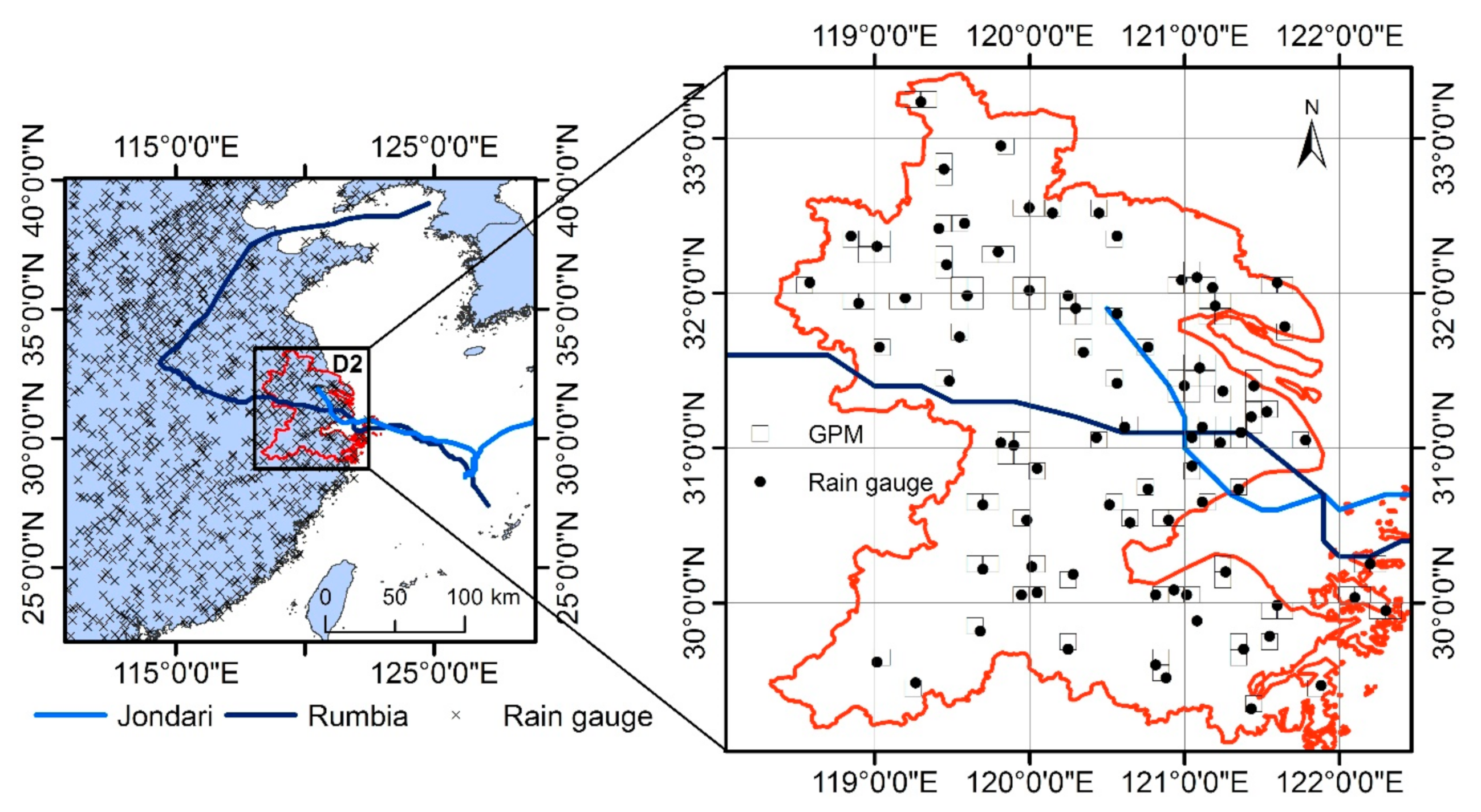

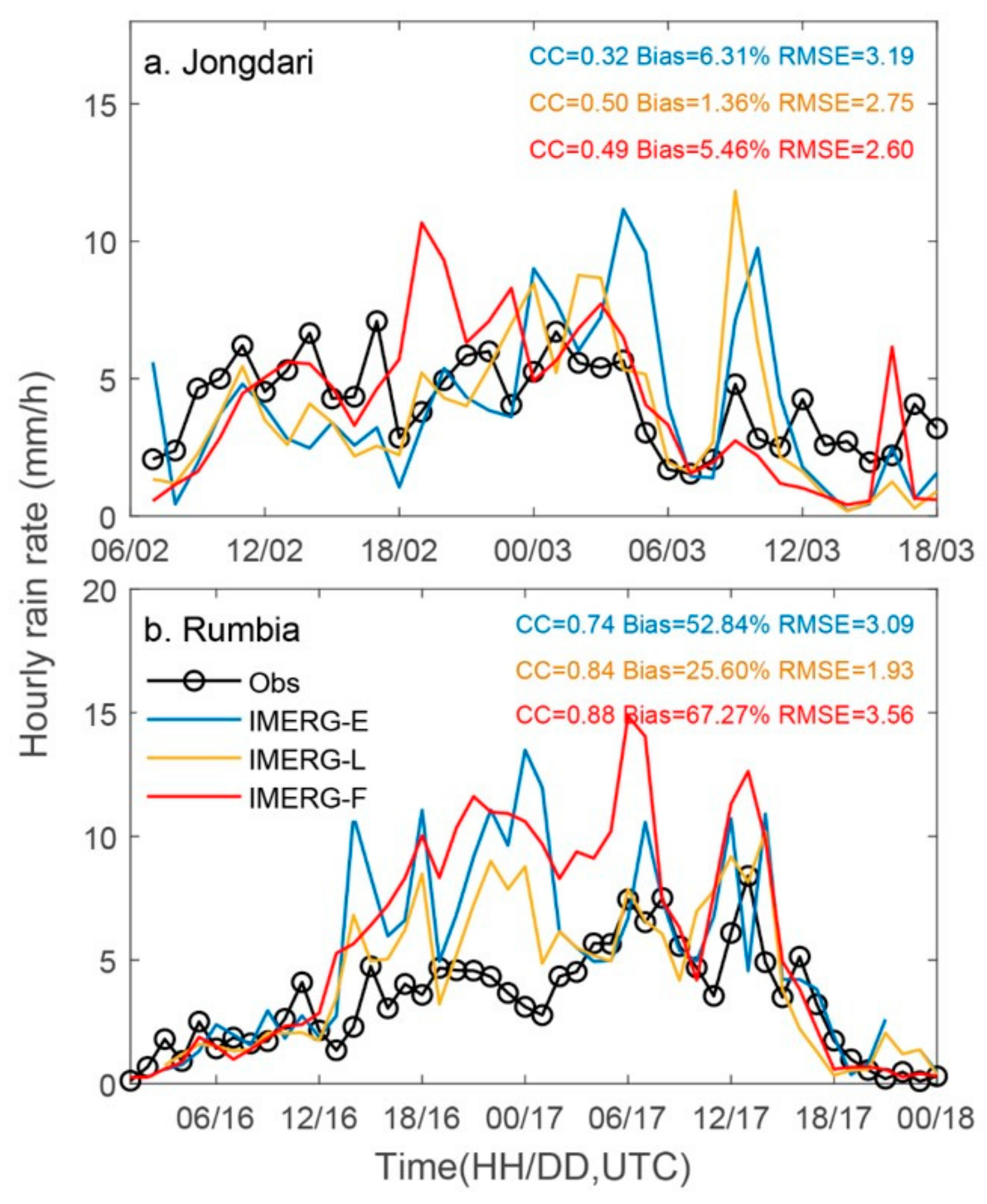
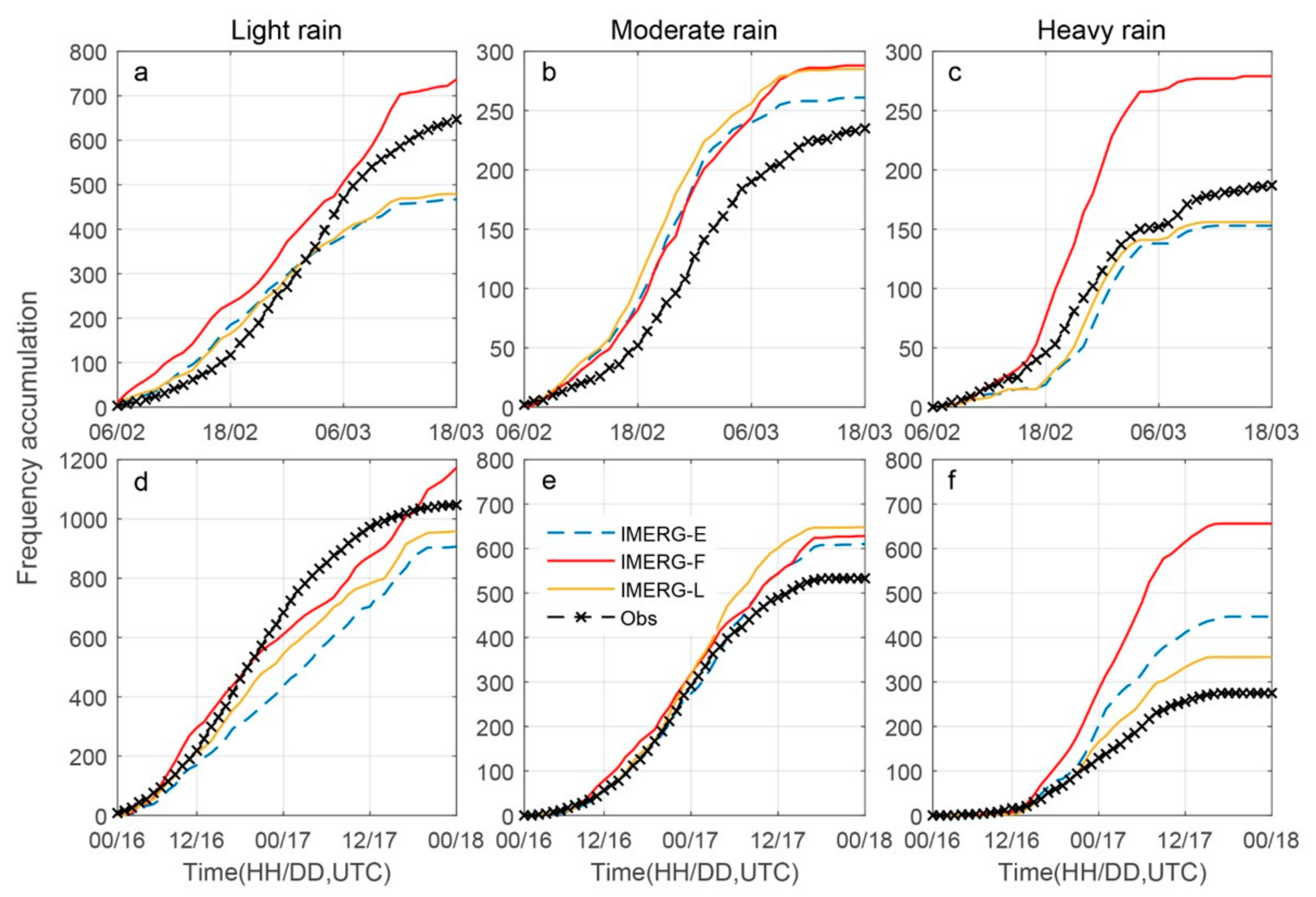
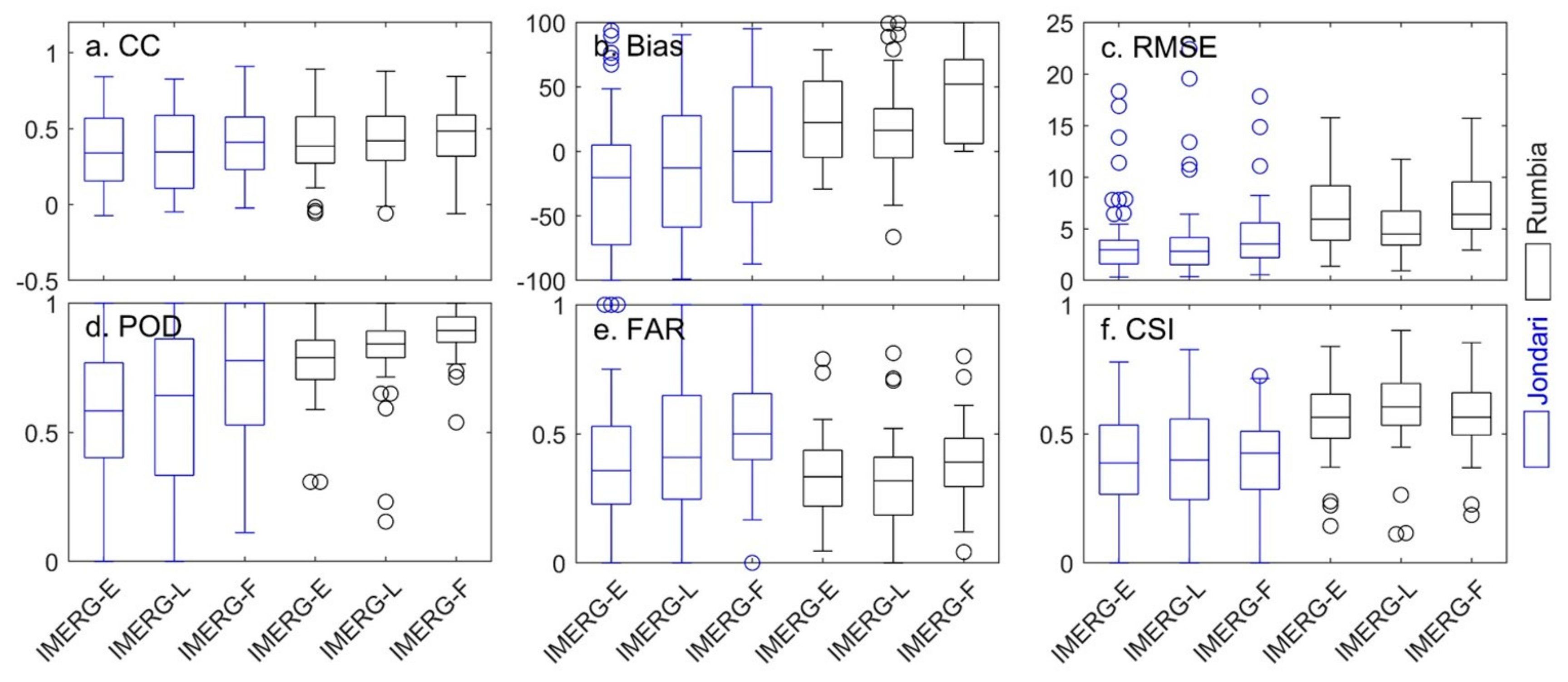
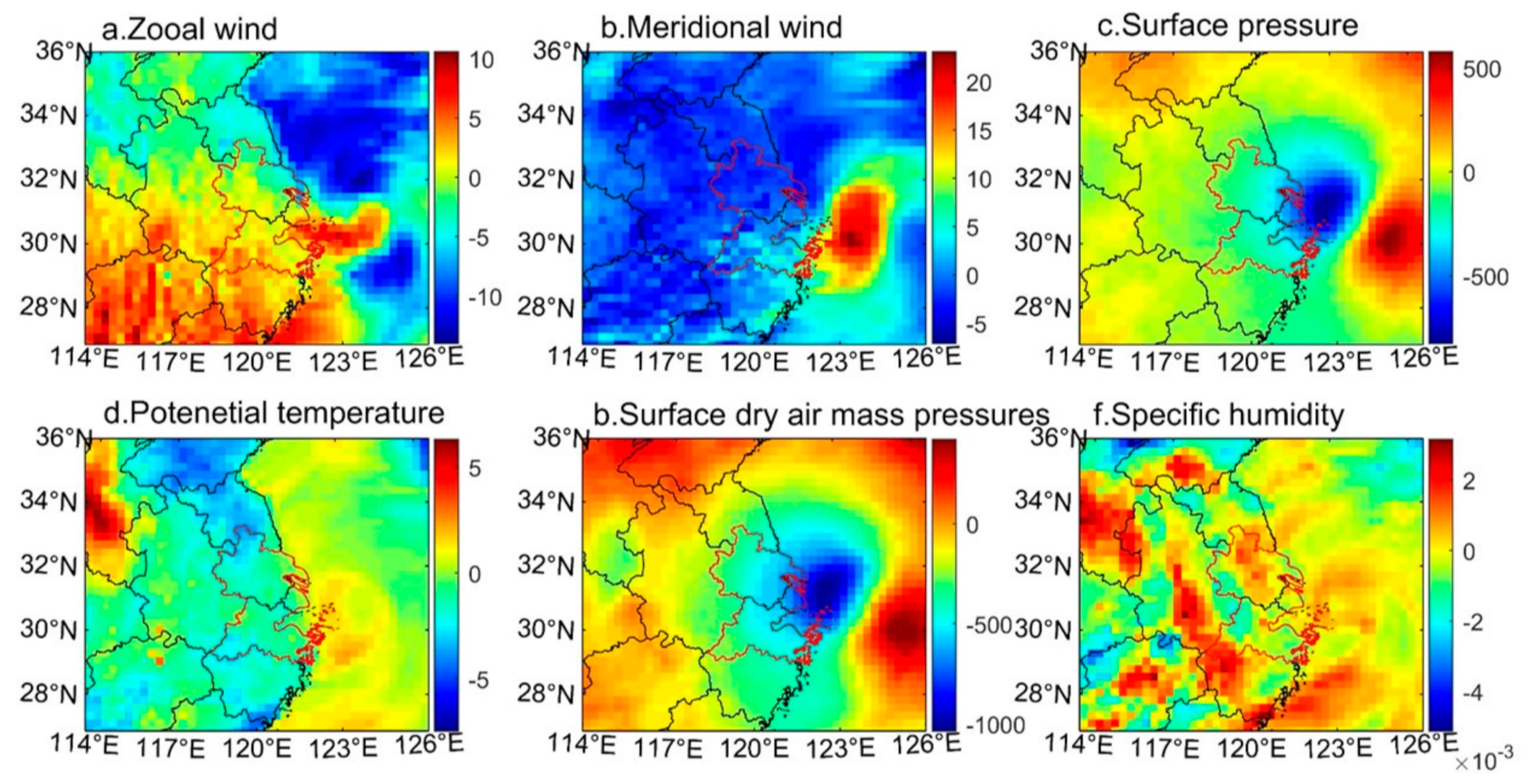
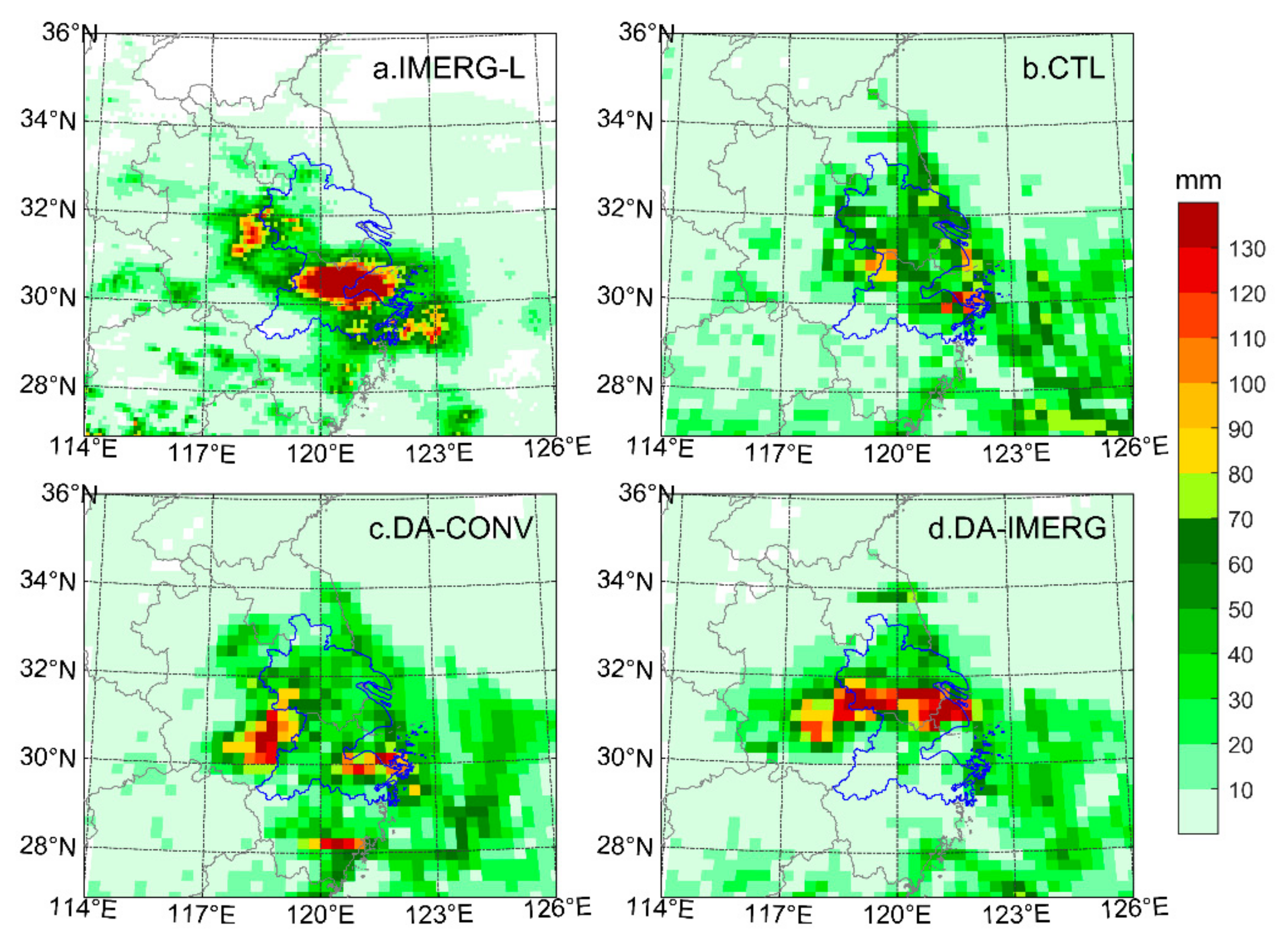
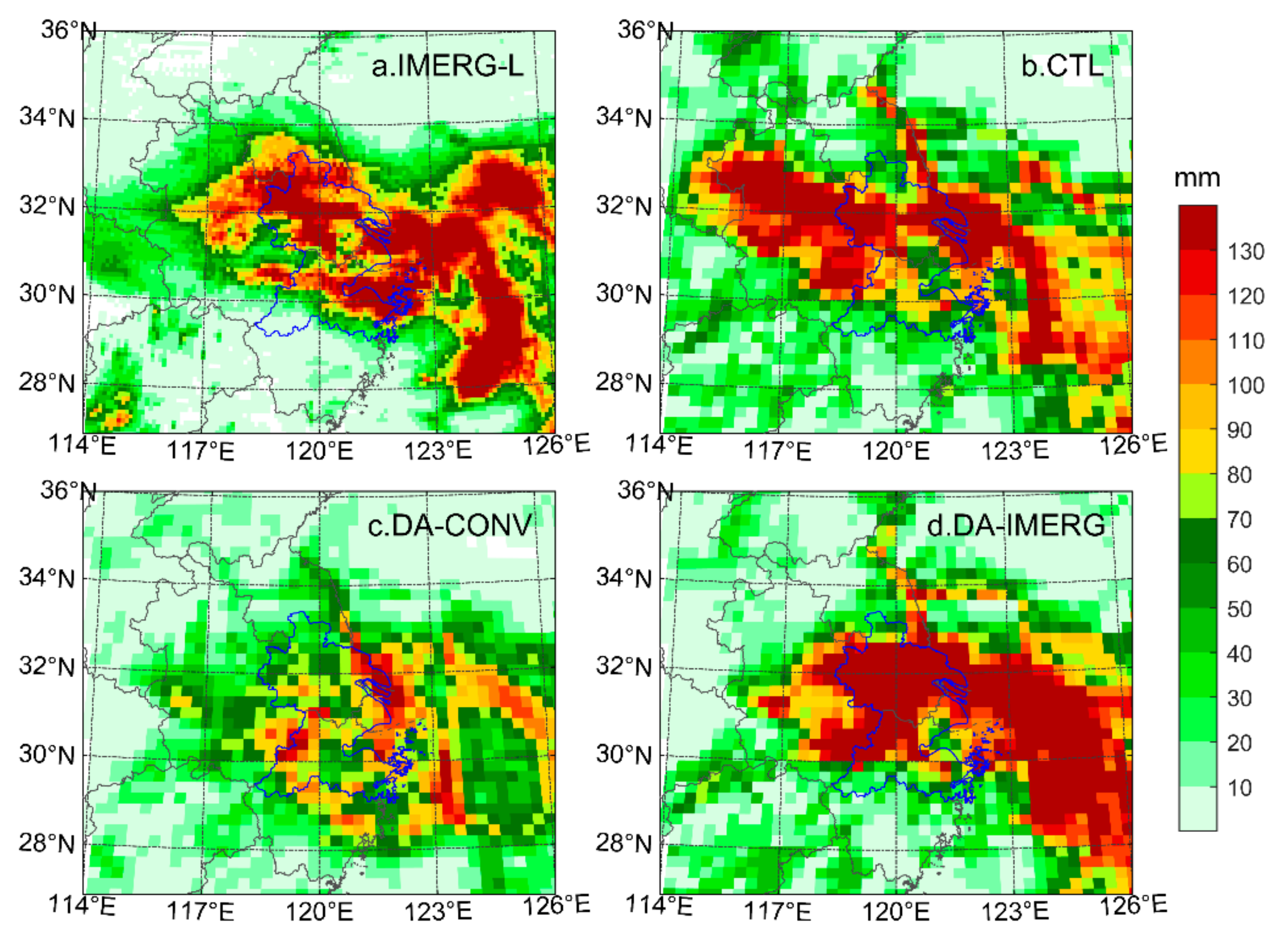
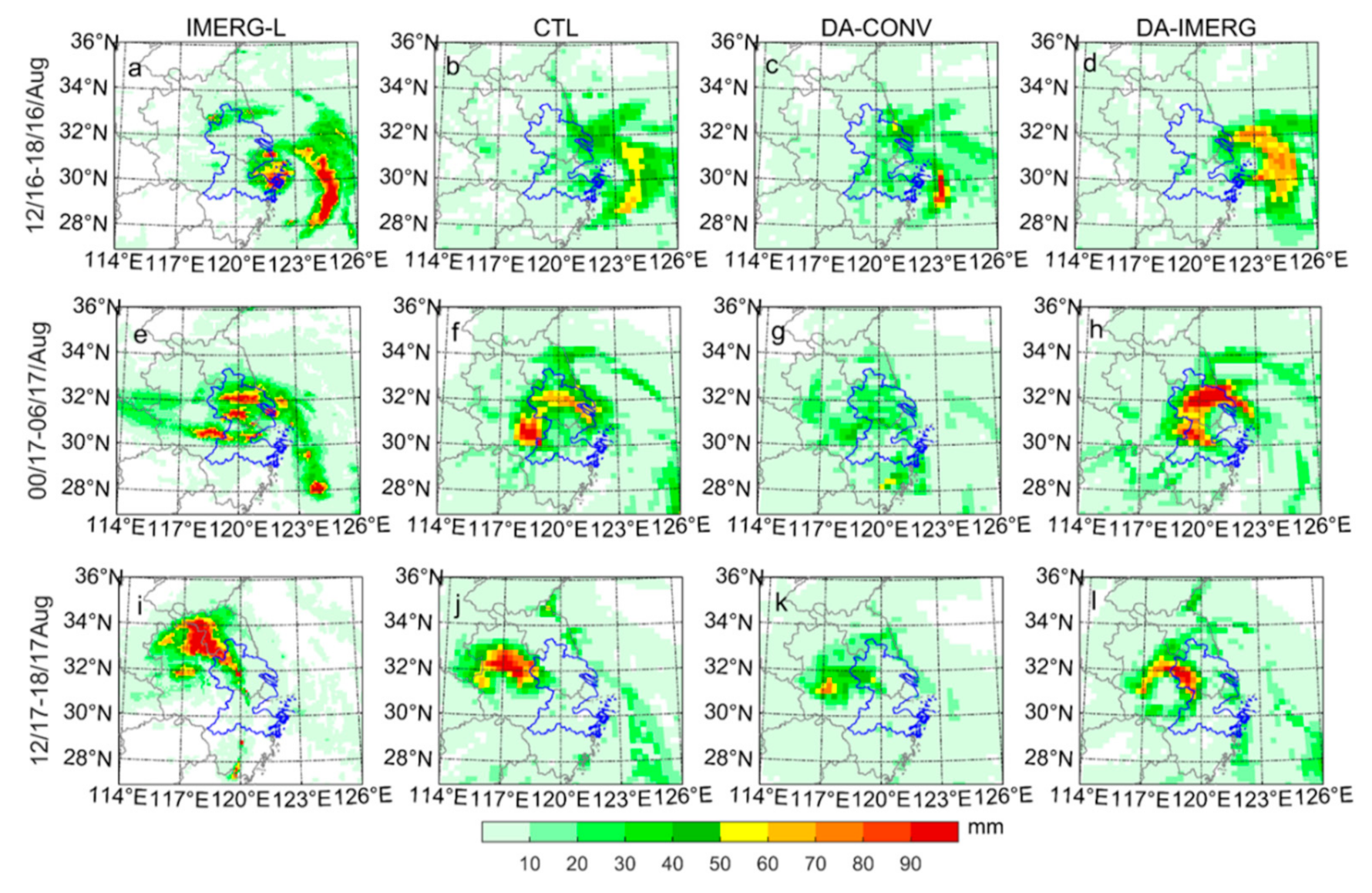
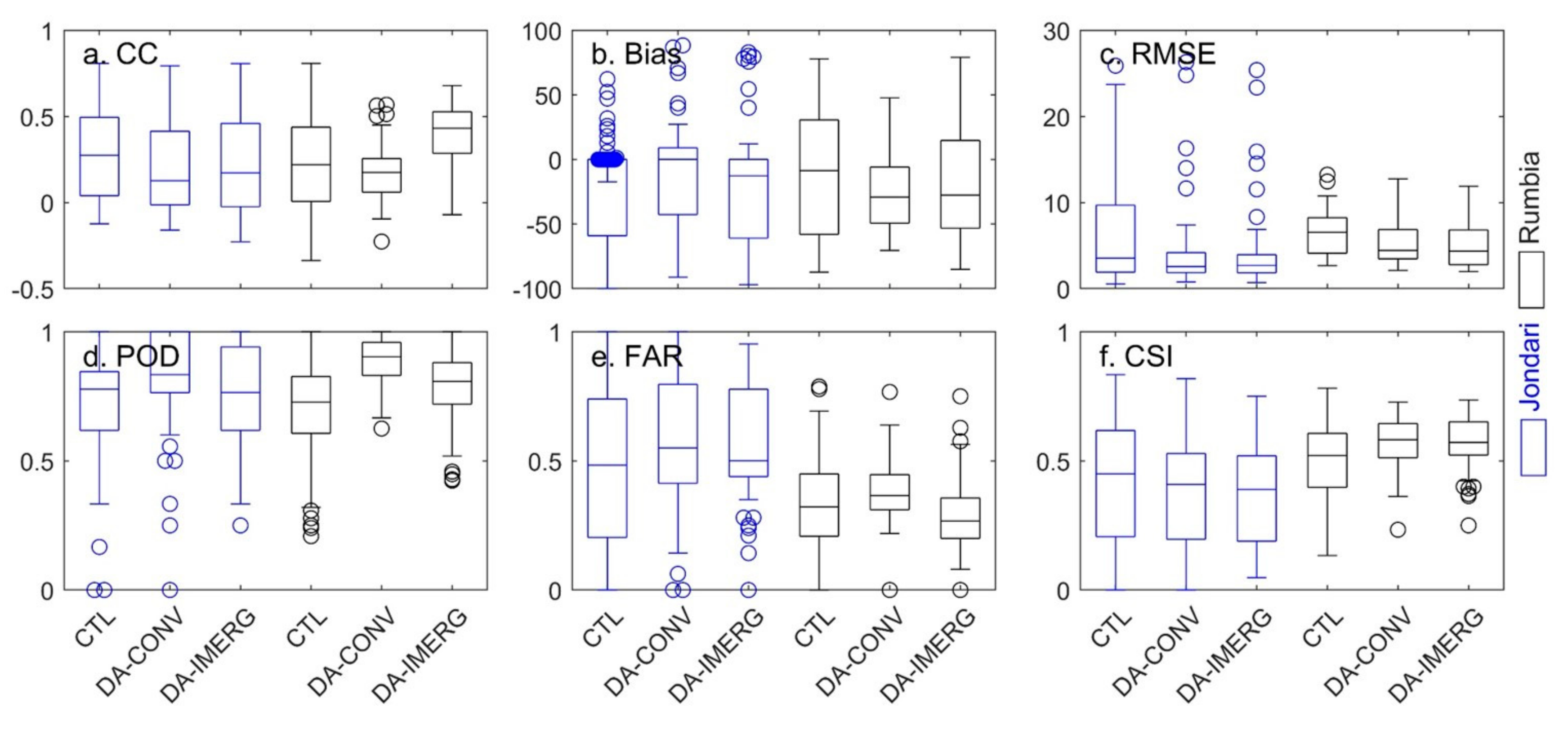
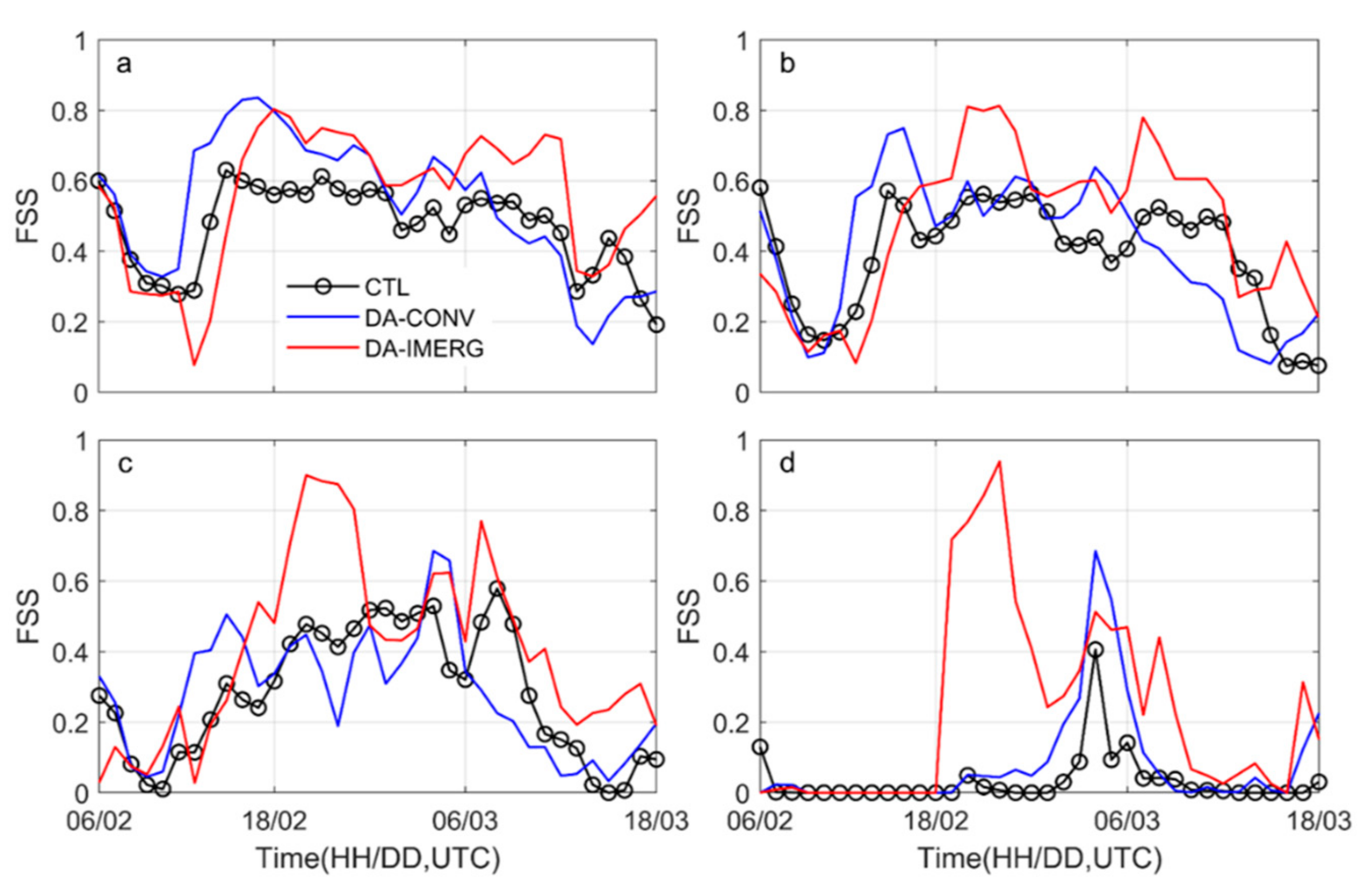
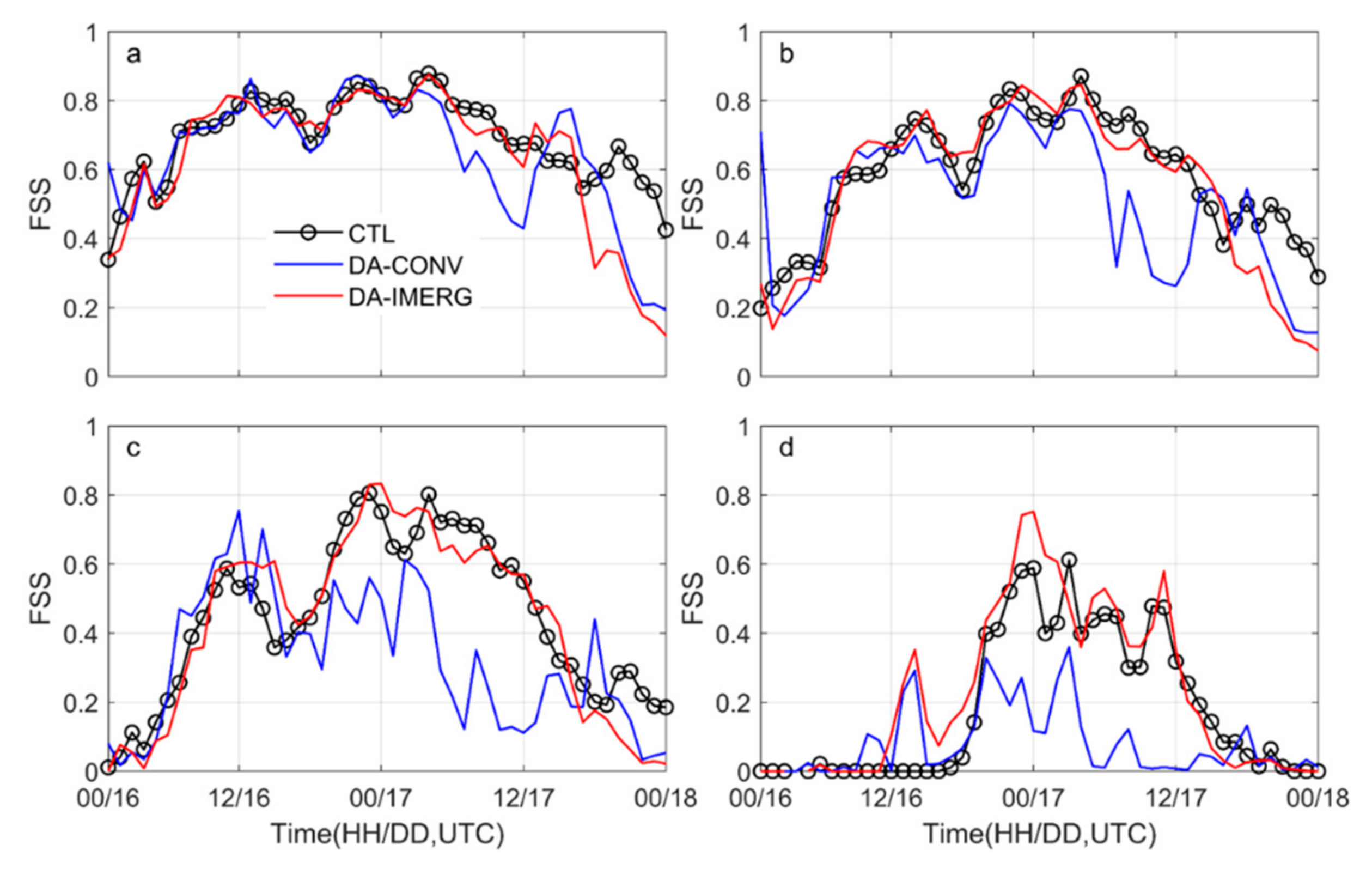
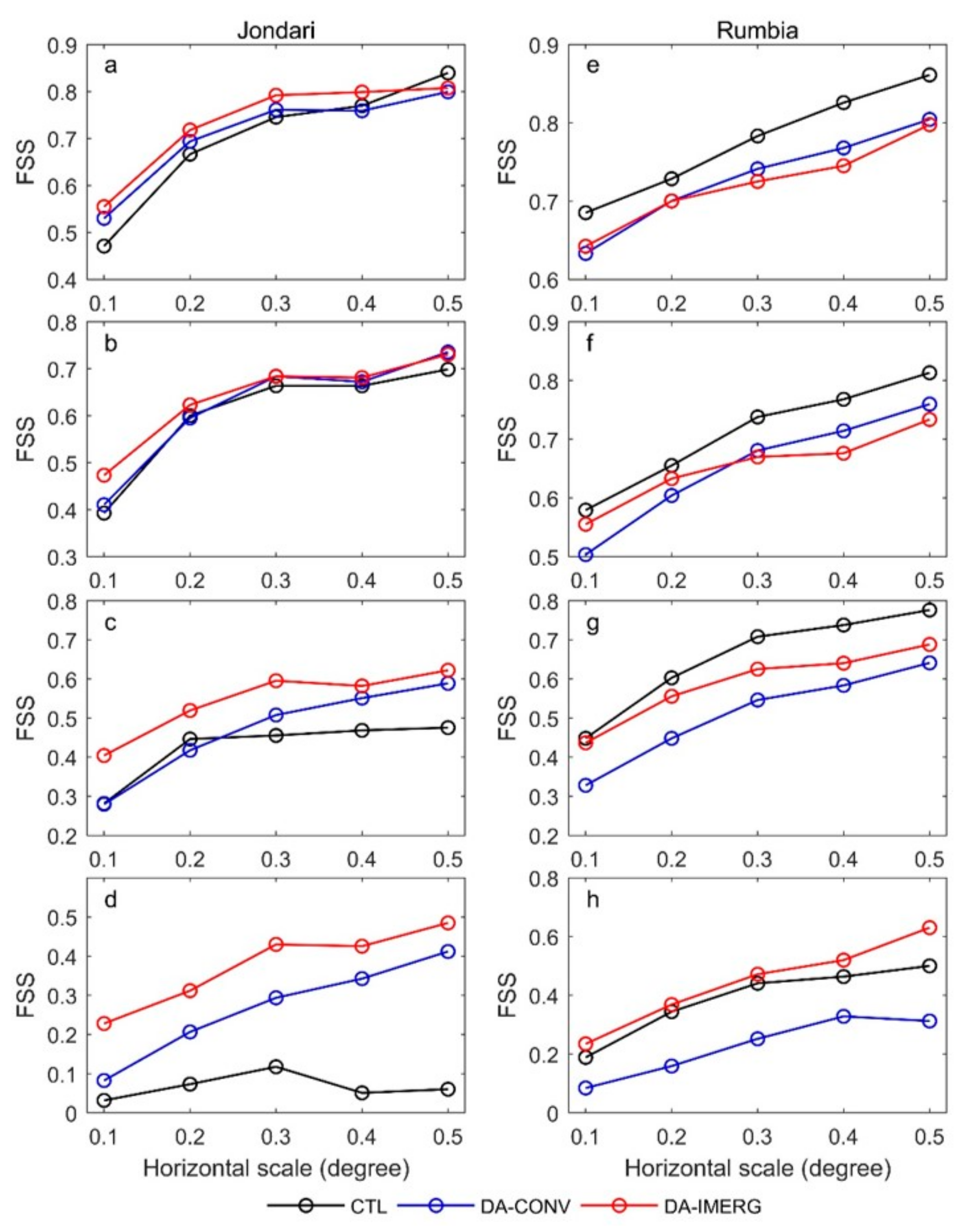
| Configuration | Outer Domain | Inner Domain |
|---|---|---|
| Model Version | Version 3.9.1 | |
| Horizontal grid | 90 × 90 | 76 × 76 |
| Grid spacing (km) | 27 | 9 |
| Vertical grids | 38 layer/Top 50hPa | |
| Time step (s) | 60 | 30 |
| Microphysics | Morrison two-moment scheme | |
| Longwave radiation | RRTMG scheme | |
| Shortwave radiation | ||
| Surface layer | Monin–Obukhov scheme | |
| Land-surface process | Noah land-surface model | |
| Planetary boundary layer process | Mellor–Yamada–Jajic TKE scheme | |
| Cumulus scheme | Kain–Fritsch (KF) | |
| Experiment | Analysis Time | Assimliation Data | |
|---|---|---|---|
| Jongdari | Rumbia | ||
| CTL | 0000 UTC 02 to 1800 UTC 03 August | 1800 UTC 15 to 0000 UTC 18 August | No |
| DA-CONV | 0600 UTC 02 to 1800 UTC 03 August | 0000 UTC 16 to 0000 UTC 18 August | Surface and upper air observations |
| DA-IMERG | 0600 UTC 02 to 1800 UTC 03 August | 0000 UTC 16 to 0000 UTC 18 August | IMERG-L |
| Statistical Indices | Unit | Equation | Target Value |
|---|---|---|---|
| Correlation coefficient (CC) | None | 1 | |
| Relative bias (Bias) | None | 0 | |
| Root-mean-square error (RMSE) | mm | 0 | |
| Probability of detection (POD) | None | 1 | |
| False alarm ratio (FAR) | None | 0 | |
| Critical success index (CSI) | None | 1 | |
| Fractions skill score (FSS) | None | 1 |
| Jongdari | Rumbia | ||||||
|---|---|---|---|---|---|---|---|
| IMERG-E | IMERG-L | IMERG-F | IMERG-E | IMERG-L | IMERG-F | ||
| CC | R < 2.5 | 0.56 | 0.59 | 0.52 | 0.41 | 0.83 | 0.81 |
| 2.5 ≤ R < 8 | 0.75 | 0.68 | 0.79 | 0.55 | 0.89 | 0.89 | |
| R ≥ 8 | 0.78 | 0.83 | 0.85 | 0.18 | 0.80 | 0.90 | |
| Bias(%) | R < 2.5 | −27.82 | −25.97 | 13.91 | −13.37 | 14.45 | 62.55 |
| 2.5 ≤ R < 8 | 11.06 | 21.28 | 22.55 | −8.40 | 21.58 | 29.45 | |
| R ≥ 8 | −18.18 | −16.58 | 49.20 | 12.03 | 17.82 | 138.55 | |
| RMSE(mm) | R < 2.5 | 10.27 | 9.90 | 11.23 | 13.24 | 5.71 | 7.39 |
| 2.5 ≤ R < 8 | 4.25 | 4.82 | 4.07 | 11.78 | 5.86 | 4.32 | |
| R ≥ 8 | 3.30 | 3.06 | 5.79 | 15.78 | 6.05 | 12.2 | |
| CC | Bias (%) | RMSE (mm) | POD | FAR | CSI | ||
|---|---|---|---|---|---|---|---|
| Jondari | IMERG-E | 0.35 | 7.12 | 3.93 | 0.56 | 0.41 | 0.38 |
| IMERG-L | 0.35 | 17.17 | 4.08 | 0.60 | 0.45 | 0.40 | |
| IMERG-F | 0.42 | 46.43 | 4.32 | 0.73 | 0.50 | 0.41 | |
| Rumbia | IMERG-E | 0.40 | 82.38 | 6.65 | 0.78 | 0.31 | 0.58 |
| IMERG-L | 0.43 | 49.85 | 5.20 | 0.83 | 0.30 | 0.61 | |
| IMERG-F | 0.45 | 135.11 | 7.52 | 0.92 | 0.39 | 0.58 |
| CC | Bias (%) | RMSE (mm) | POD | FAR | CSI | ||
|---|---|---|---|---|---|---|---|
| Jondari | CTL | 0.28 | 3.73 | 5.92 | 0.71 | 0.47 | 0.42 |
| DA-CONV | 0.21 | 15.88 | 4.41 | 0.81 | 0.57 | 0.39 | |
| DA-IMERG | 0.20 | −4.81 | 4.32 | 0.73 | 0.58 | 0.36 | |
| Rumbia | CTL | 0.23 | 25.29 | 6.44 | 0.69 | 0.35 | 0.49 |
| DA-CONV | 0.18 | −19.25 | 5.44 | 0.89 | 0.39 | 0.56 | |
| DA-IMERG | 0.41 | −13.84 | 5.09 | 0.78 | 0.30 | 0.57 |
© 2020 by the authors. Licensee MDPI, Basel, Switzerland. This article is an open access article distributed under the terms and conditions of the Creative Commons Attribution (CC BY) license (http://creativecommons.org/licenses/by/4.0/).
Share and Cite
Wang, J.; Xu, Y.; Yang, L.; Wang, Q.; Yuan, J.; Wang, Y. Data Assimilation of High-Resolution Satellite Rainfall Product Improves Rainfall Simulation Associated with Landfalling Tropical Cyclones in the Yangtze River Delta. Remote Sens. 2020, 12, 276. https://doi.org/10.3390/rs12020276
Wang J, Xu Y, Yang L, Wang Q, Yuan J, Wang Y. Data Assimilation of High-Resolution Satellite Rainfall Product Improves Rainfall Simulation Associated with Landfalling Tropical Cyclones in the Yangtze River Delta. Remote Sensing. 2020; 12(2):276. https://doi.org/10.3390/rs12020276
Chicago/Turabian StyleWang, Jie, Youpeng Xu, Long Yang, Qiang Wang, Jia Yuan, and Yuefeng Wang. 2020. "Data Assimilation of High-Resolution Satellite Rainfall Product Improves Rainfall Simulation Associated with Landfalling Tropical Cyclones in the Yangtze River Delta" Remote Sensing 12, no. 2: 276. https://doi.org/10.3390/rs12020276
APA StyleWang, J., Xu, Y., Yang, L., Wang, Q., Yuan, J., & Wang, Y. (2020). Data Assimilation of High-Resolution Satellite Rainfall Product Improves Rainfall Simulation Associated with Landfalling Tropical Cyclones in the Yangtze River Delta. Remote Sensing, 12(2), 276. https://doi.org/10.3390/rs12020276




